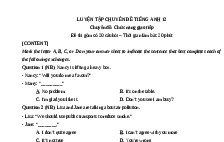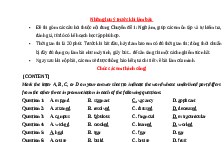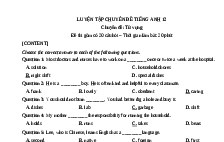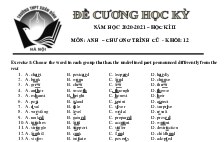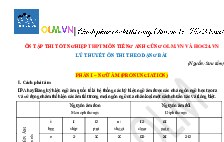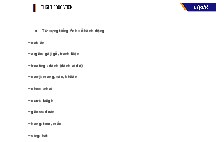Giải bài tập SGK Tiếng Anh lớp 12 Unit 2: Reading - Writing
Nội dung tài liệu
Tải xuống
Link tài liệu:
Các tài liệu liên quan
-
![Đề luyện tập Chuyên đề 3: Chức năng giao tiếp]()
-
![Đề luyện tập Chuyên đề 1: Ngữ âm]()
-
![Đề luyện tập Chuyên đề 2: Từ vựng]()
-
![Tài liệu ôn tập HKII năm học 2020-2021 môn Tiếng Anh 12 chương trình cũ, trường THPT Xuân Đỉnh - Hà Nội]()
-
![Lý thuyết ôn thi THPT môn Tiếng Anh theo dạng bài]()
-
![UNDERSTAND]()
-
![TỪ VỰNG VỀ CÁC MÔN HỌC]()
-
![Tuyển tập truyện ngắn song ngữ Anh-Việt hay]()
-
![Tuyển tập truyện cổ tích bằng tiếng Anh]()
-
![TỪ VỰNG VỀ HÀNH ĐỘNG]()
Có thể bạn quan tâm
Thông tin tài liệu
Doc24.vnGiải bài tập SGK Tiếng Anh lớp 12 Unit 2: Reading WritingReading Unit trang 20 Tiếng Anh 12 Before you read Work in pairs. Discuss the question: Which of the following factors is the most important for ahappy life? Why?□ love money parents’approval□ nice house flat good job good health Which of the above factors is the most important for happy life? B. In my opinion, love, good health and good job are the most important For happy life. A. Why? As we know, love, espcciallv the true love, is an essential factor for marriage life. Someonecompares love with light or water to life. Indeed, with love we can suffer the hardship, sufferings ormisfortunes of life. And there’s an important aspect of love: forgiveness. We can say love andforgiveness arc two unseparable qualities. A. What about good health? Is it also indispcndable too? Sure. Imagine! Can you work or live happy life if you are in ill health? A. Absolutely no. B. And good job can provide you with money cnoush for your life and your family, becausemoney is means (if comfort. A. OK. quite agree with you. While You Read Read the text and do the tasks that follow (Đọc bài đọc và làm những bài tập kèm theo) Theo truyền thống người Mĩ và người châu có những tưởng rấi khác nhau về tình yêu và hônnhân. Người Mĩ tin hôn nhân" lãng mạn” một cậu trai và một cô gái cảm thấy thích nhau, yêunhau và quyết định cưới nhau. Trái lại, ngườỉ châu tin hôn nhân “có tính giao ước" cha mẹ củaDoc24.vncô dâu và của chú rể quyết định việc hôn nhân và tình yêu nếu có phát triển được nghĩ là sự tiếpnối hôn nhân, chớ không có trước nó. Để chứng tỏ những sự khác biệt một cuộc khảo sát được tiến hành giữa các sinh viên Mĩ, TrungQuốc và Ấn để quyết định thái dộ của họ đối với tình yêu và hôn nhân. Sau đấy là bản tóm tắt các câuhỏi của mỗi nhóm cho bốn tưởng quan trọng. Nét hấp dãn thể chất: Sinh viên Mĩ quan tâm nhiều về nét hấp dẫn thể chất hơn sinh viên Ân vàTrung Quốc khi họ chọn vợ hay chồng. Họ cũng đồng rằng người vợ nên giữ vẻ đẹp và ngoại hìnhcủa mình sau hôn nhân. Chia sẻ: Ít sinh viên châu đồng quan điểm của sinh viên Mĩ vợ và chồng nên chia sẻ mọi nghĩvới nhau. Thực vậy, đa số sinh viên Ân và Trung Quốc thực sự nghĩ rằng không thảo luận một số vấnđề, chia sẻ một số tưởng nào đó là tốt và khôn ngoan hơn. Đặc biệt rất nhiều người Ấn đồng rằnggiãi bày tâm sự với vợ là không khôn ngoan. Mối tương quan của người ngang hàng: Đa số sinh viên châu bác bỏ quan điểm của người Mĩhôn nhân là mối tương quan giữa những người ngang hàng với nhau, không đòi hỏi ít hay nhiều hơnở nhau. Đa số sinh viên Ân đồng rằng trong hôn nhân đàn bà phải hi sinh nhiều hơn đàn ông. Tín nhiệm xây dựng trên tình yêu: Đáng chú ý, nhiều sinh viên châu hơn sinh viên Mĩ đồng ýrằng người chồng bắt buộc nói cho vợ nơi anh ta đã đi nếu anh về nhà muộn. Người vợ châu có thểyêu cầu báo cáo những hoạt động của chồng. Người vợ Mĩ, chẳng hạn, tin chồng mình làm điều đúngvì anh yêu cô chứ không vì anh bắt buộc phải làm. Sự so sánh bốn tưởng về tính lãng mạn cho thấy người trẻ châu không lãng mạn bằng người Mĩđồng trang lứa. Task 1: Explain the meaning of the italicized words phrases in the following sentences. (Giải thichnghĩa của những từ/cụm từ in nghiêng ởnhững câu sau.) 1. precede: happen or exist before 2. determine: find out 3. confide: tell someone about somethine very private or secret. 4. sacrifice: willingly Stop having something you want.Doc24.vn obliged: having duty to do something. Task 2: Answer the following questions. (Trả lời các câu hỏi sau.) 1. They arc “trust built on love, physical attractiveness, confiding and partnership of equals.” 2. The Americans are much more concerned with it than the Indians and the Chinese when choosinga wife or husband. 3. The Indian students agree lhal woman has lo sacrifice more in marriage than man. 4. The American wife trusts her husband to do the right thing because he loves her not because hehas to. 5. The main finding of the survey is young Asians are not as romantic as their Americancounterparts. After You Read Work ill groups Discuss the question: “What are ihe differences between traditional, Vietnamesefamily and modem Vietnamese family?” (Là việc từng nhóm. Thảo luận câu hỏi:" Sự khác biệt giữagia đình Việt Nam truyền thống và gia đình Việt Nam hiện đại?”) A. see the traditional Vietnamese family as well as family life is changing lot. modernVietnamese family is quite different from the traditional one. B. Thai’s right. First, in my opinion, it's the size. traditional family was usually an extendedfamily, that is there are more than one generation living together under one roof. C. But now modern family is usually nuclear family, consisting of only parents and theirchildren. D. OK. And the key fact we should mention is the number of children. traditional family wasusually large one, with more than three. In some families, people could find the number of childrenup to ten or even more. On the contrary, modem family, especially families in big cities, has onlyone or two children at most.Doc24.vn A. Next, in traditional family, the father takes all responsibilities for the family. In other words,father works and earns money to support the whole family. The woman’s tasks are confined withinthe family: bearing children and doing all the housework. B. Now in modem family, both husband and wife have to work to support the family. C. And what’s more husband and wife should share household work together. D. That's the interesting idea about the modern family: everyone in family has his her ownresponsibility to do, that is he she should take part in the maintenance or the building of the family'shappiness. A. OK. The husband and the wife must have the partnership of equals in the family: no one issuperior to the other. Both have their corresponding responsibilities for his /her own.Writing Unit trang 25 Tiếng Anh 12Task 1: You are going to write about the conical leaf hat or the nón lá”, symbol of Vietnameseculture. Look at the picture below. Find the Vietnamese equivalents for the English words. (Em địnhviết về “nón lú", một biểu tượng của văn hóa Việt. Nhìn vào hình tượng đây Tìm từ tương đươngtiếng Việt cho những từ tiếngAnh.) 1. leaf: lá 2. rim: vành nón 3. ribs: khung nón 4. strap: quai nón Task 2: Write passage of about 150 words about the conical leaf hat of Vietnam, using the outlineand information below. (Viết một đoạn văn khoảng 150 từ về “nón lá", dùng dàn bài và thông tin dướidây.) Symbol of the Vietnamese Culture: The Conical Leaf HatIntroduction: symbol of Vietnamese girls/women part of the spirit of the Vietnamese nationMain body:Materials special kind of bamboo and young/soft palmDoc24.vnShape and size Process leaves conical form diameter: 45 50 cm; 25 30 cm high covering the form with leaves/sewing leavesaround ribsConclusion: protecting people from sun rain girls/women look pretty/attractive When you come to the countryside of Vietnam, especially in Hue, you can see lot of beautifulgirls with palm leaf conical hat on. The conical leaf hat is said the symbol of the Vietnameseculture. The hat is made from special kind of bamboo and young and soft palm leaves. The ribs are shapedinto conical form. The diametre of the hat is usually about between forty and fifty-five centimetres;and it is about twenty-five or thirty centimetres high. The ribs are covered with palm leaves which aretightly stiched onto the bamboo frame. Finally, the hat is usually painted with coat of furniture -poiish oil. The palm leaf conical hat is mainly used to protect from shine or rain. Beneath the broad rim of thehat do Vietnamese girls look more attractive and charming.Trên đây chỉ là phần trích dẫn 10 trang đầu của tài liệu và có thế hiển thị lỗi font, bạn muốn xem đầyđủ tài liệu gốc thì ấn vào nút Tải về phía dưới.


